Coast Views
- Details
- Written by Sarama Sarama
- Category: Coast Views Coast Views
- Published: 19 April 2016 19 April 2016
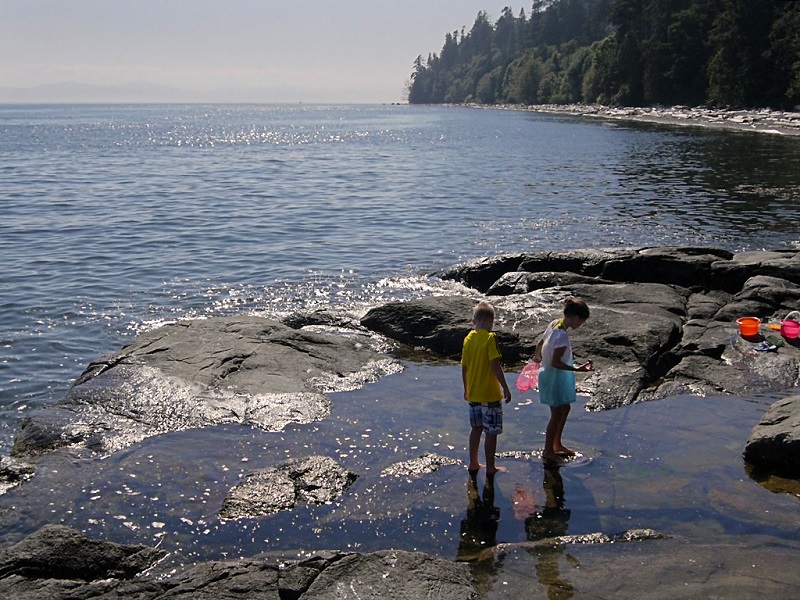 Children at Secret Beach by the Salish Sea. All photos by Sarama unless otherwise noted.
Children at Secret Beach by the Salish Sea. All photos by Sarama unless otherwise noted.
After leaving the Enron Corp., former Enron executives, Rich Kinder and William Morgan formed the Kinder Morgan company in 1997, which took over the liquid pipeline assets of Enron. In 2005 Kinder Morgan (Canada) bought the Trans Mountain pipeline and became its 100% owner. (So, I will mostly use, Kinder Morgan, the name of the parent company.) On Dec. 16, 2013 Trans Mt. filed an application to expand its facilities, to triple capacity.This pipeline expansion project will deliver a devastating barrage of toxic “bombs,”exploding in slow motion through space-time, through the matrix of life, through unseen generations, globally, nationally, regionally, and with direct impacts, locally.
1. The first bomb: The Tar Sands extraction project is the single largest point source of green house gas emissions in Canada, and the single largest engineering/mining/extractive project on the face of the earth. The Tar Sands are the size of England.The Athabasca Tar Sands project is extreme dirty fossil fuel extraction. It is poisonous, enormous, deadly, and hellish beyond description. Just ask the First Nations people of Fort Chipewyan, who live downstream from this sacrifice zone of mines, processing plants, and tailings waste lakes, which are leaking toxins into the Athabasca River.These indigenous people are part of the “sacrifice zone” and are dying of cancers.These types of cancers are very rare in the rest of the Canadian population.
A Greenpeace aerial view of a typical scene of the Athabasca forest, in Northern Alberta, before tar sandsmining/extraction, from the film Petropolis, by Peter Mettler.
Greenpeace aerial view of tar sands bitumen extraction, from the film, Petropolis, by Peter Mettler.A Greenpeace aerial view of a tar sands processing plant, from the film, Petropolis by Peter Mettler.
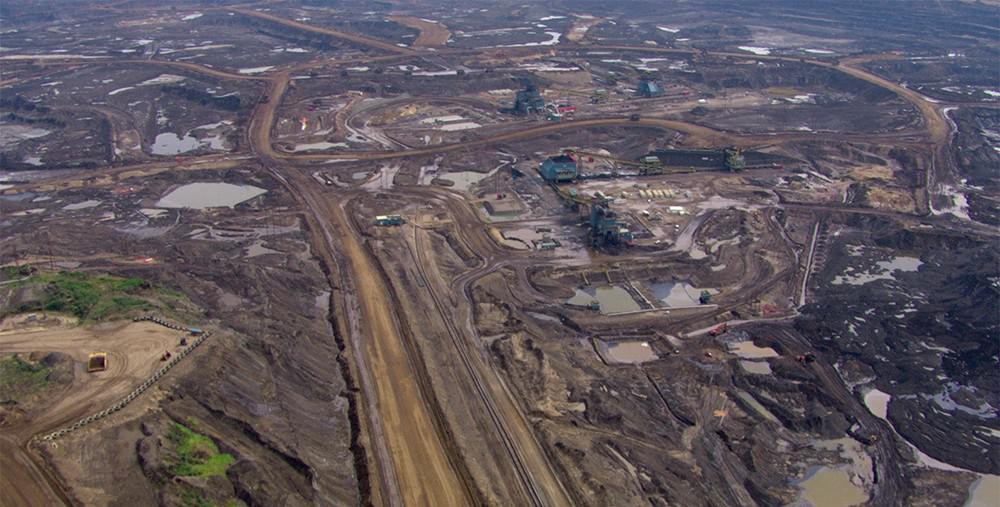
The Healing Walk at the Tar Sands, in July, 2013.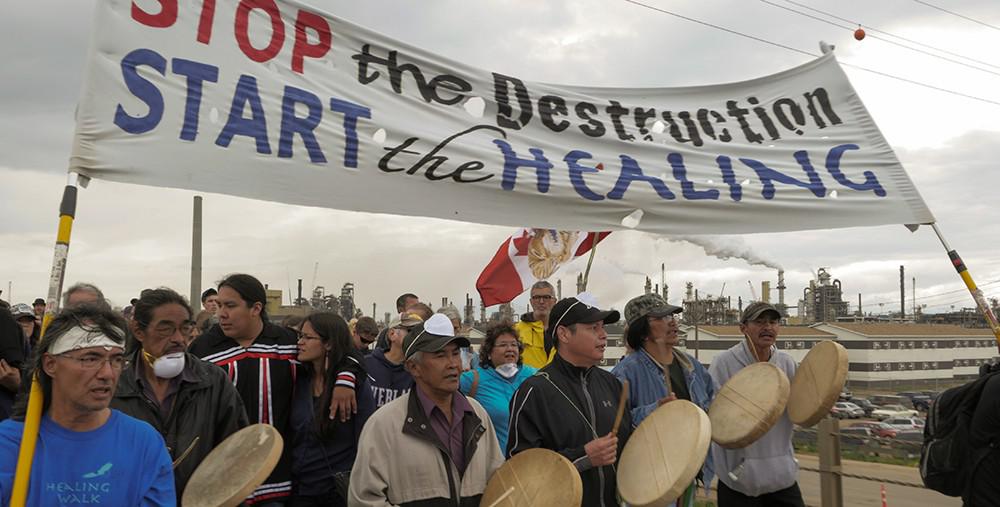
An excerpt from an article in the Earth Island Journal: Deformed Fish Found Downstream of Tar Sands Mines, by Jason Mark, June 13, 2012
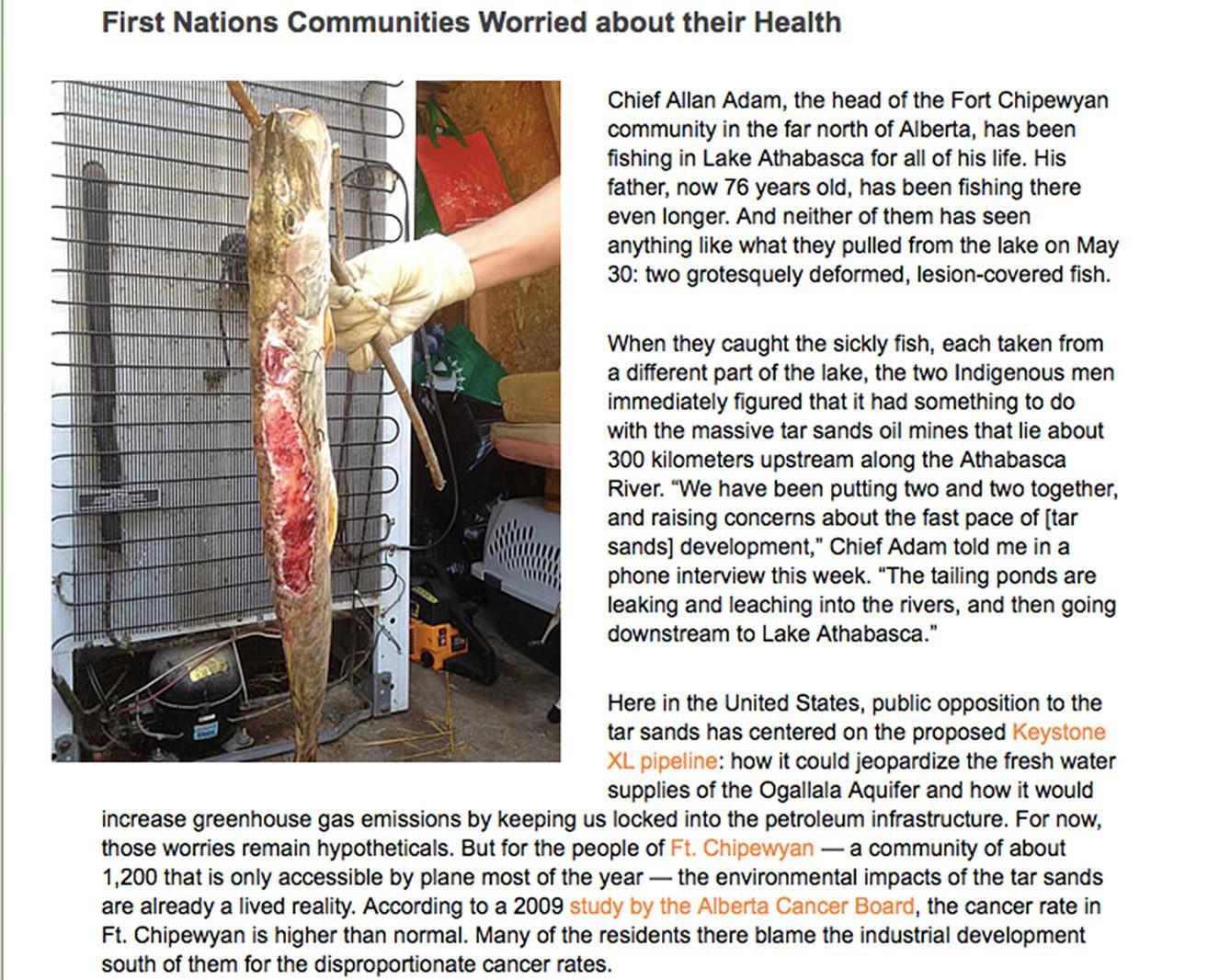

Tailings waste “pond” in the foreground, as large as a lake. The air is foul, smells of polycyclic aromatic hydrocarbons and reduces visibility. It sounds like a war zone, with continuous cannon fire from floating platforms, to scare off migratory birds from landing on the toxic lakes.
An excerpt from the article: Tar sands ‘fingerprints’ seen in rivers and snow, in Science News, by Janet Raloff, Aug. 31, 2010.
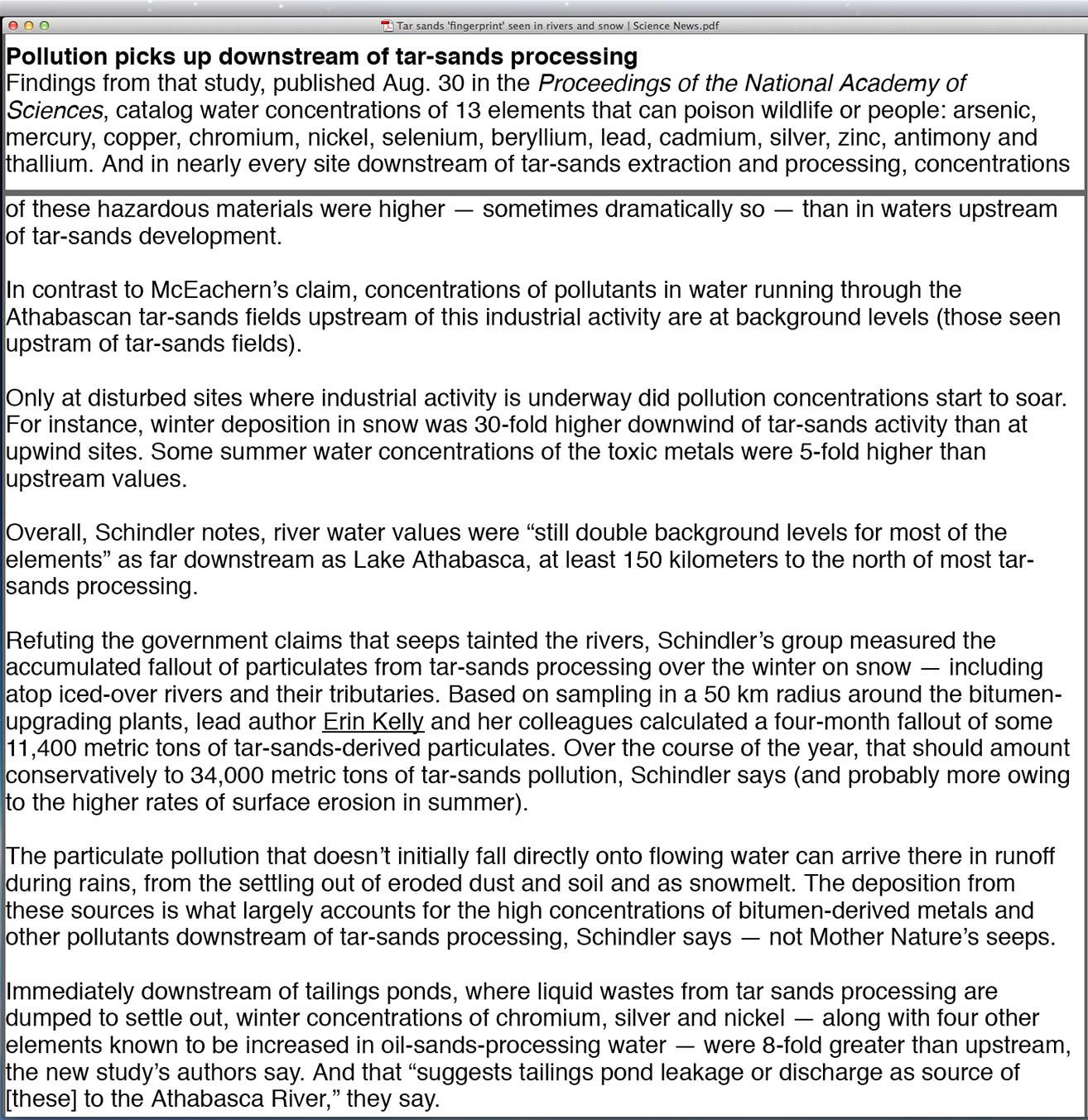
After nearly 16 years of health service at Fort Chipewyan, Dr. John O’Conner was fired, in April, 2015. Earlier, he had made the news when speaking out about the elevated cancer rate in Northern Alberta communities, believing them to be linked to tar sands activities.
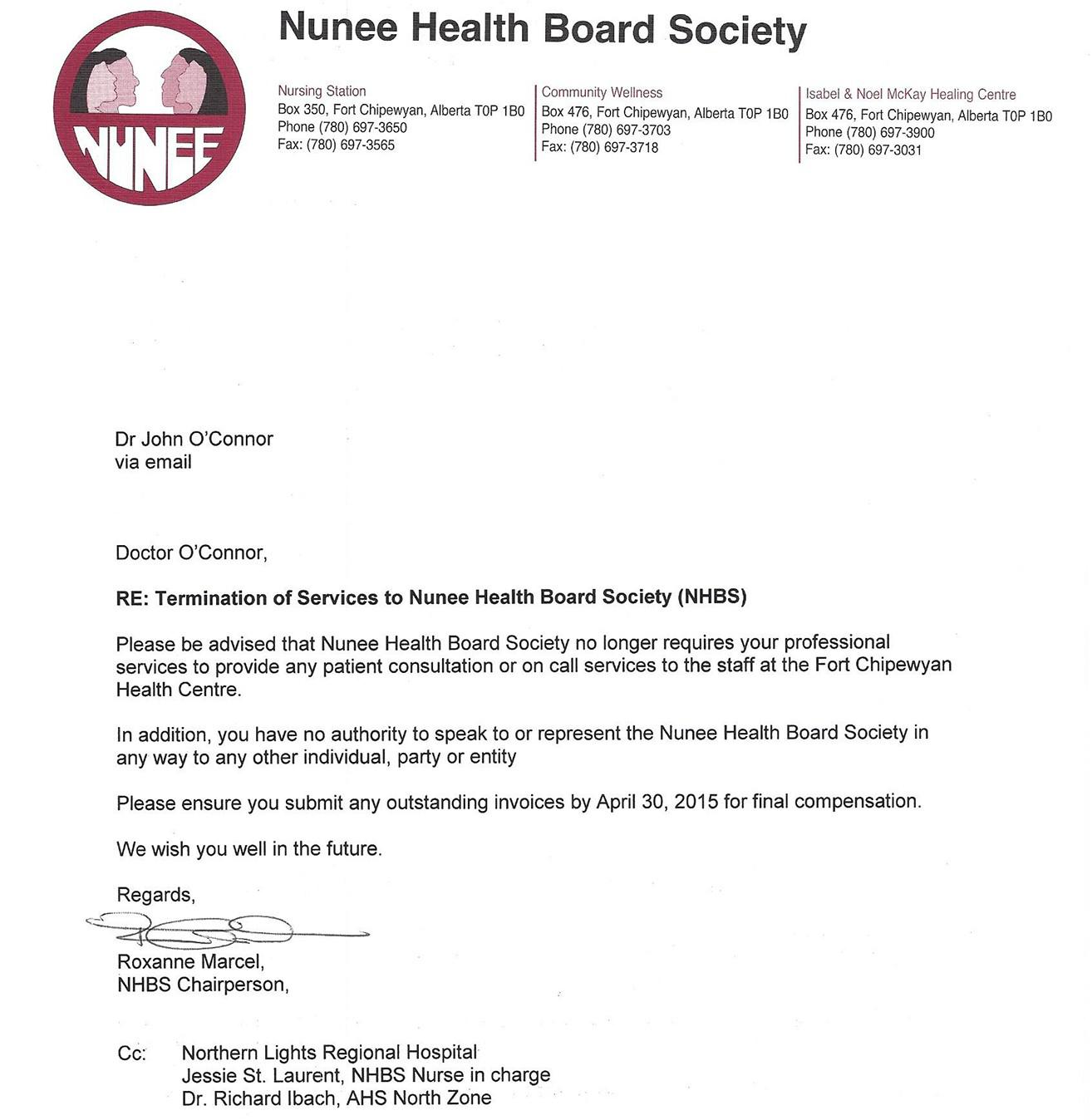
This is an excerpt from an article in the APTN National News, by Brandi Morin, May 11, 2015, regarding some of the circumstances of Dr. O’Conner’s firing.
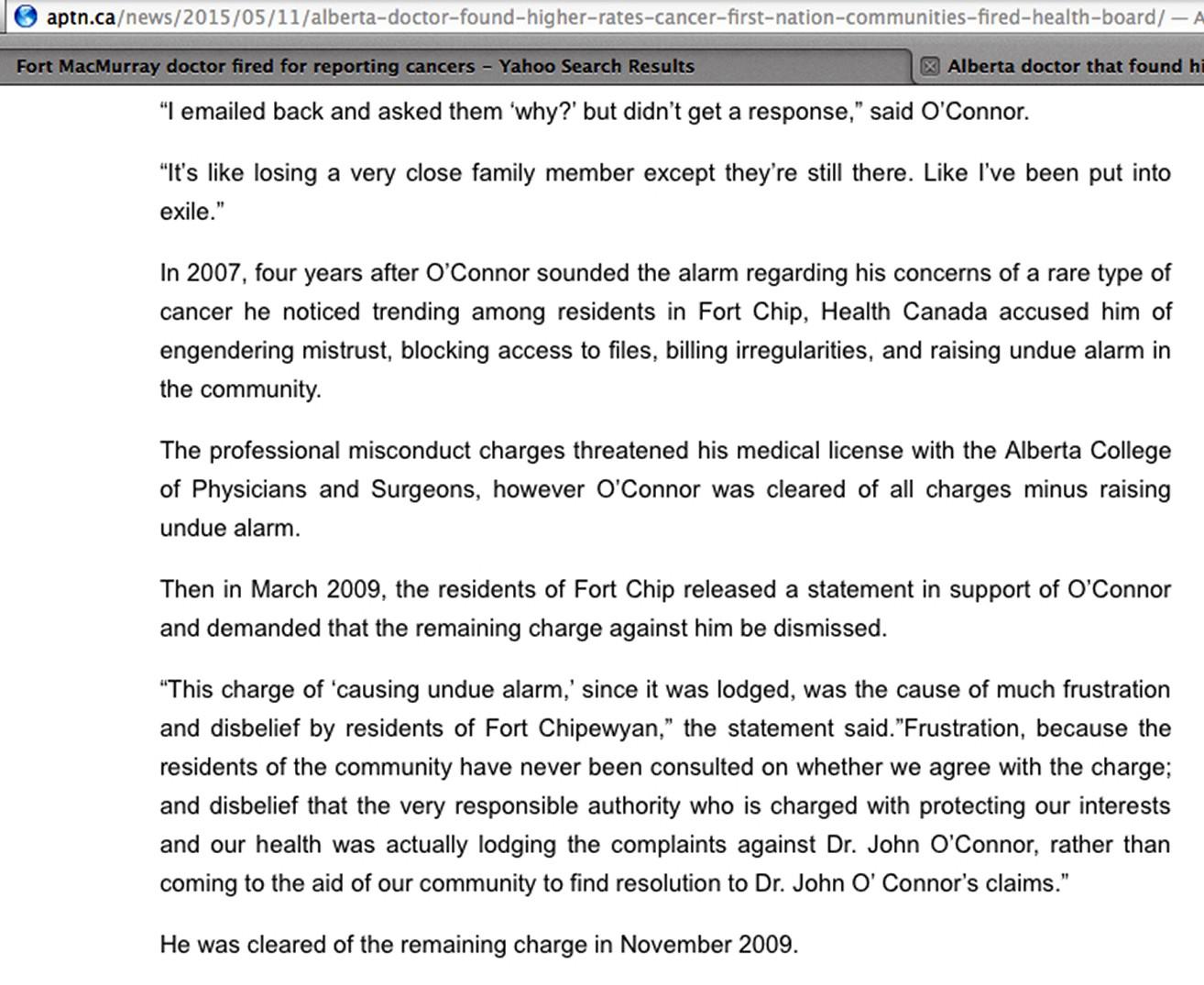
In the Harper era, firings, muzzling of science and scientists, covert surveillance and suppression of legitimate democratic public activities of First Nations people and concerned citizens who were active on environmental issues, including investigative auditing of environmental organizations by Revenue Canada, were all standard practice. This is just a brief summary of how corporate fossil fuel control and profit interests were elevated, while democracy was degraded.
The new Kinder Morgan pipeline, if built, will further tar sands extraction, to continue, and to grow. The legacy of tars sands extraction and bitumen burning will haunt future generations, long after we are gone.
2. The second bomb: A plan to build a new three-foot diameter pipeline, along a route corresponding roughly to the 1150 km route of the existing two-foot diameter pipeline, from Edmonton, Alberta, terminating at Burrard Inlet, B.C.Many pumping stations are along the route.
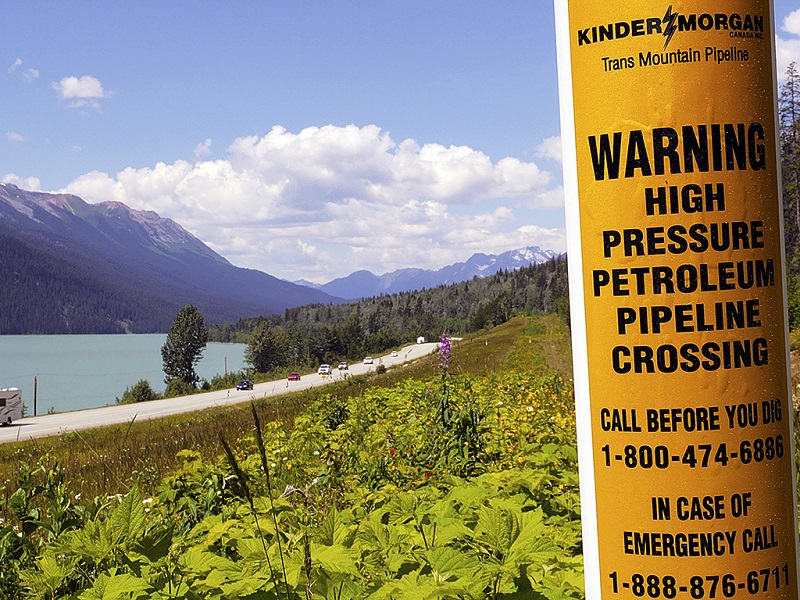
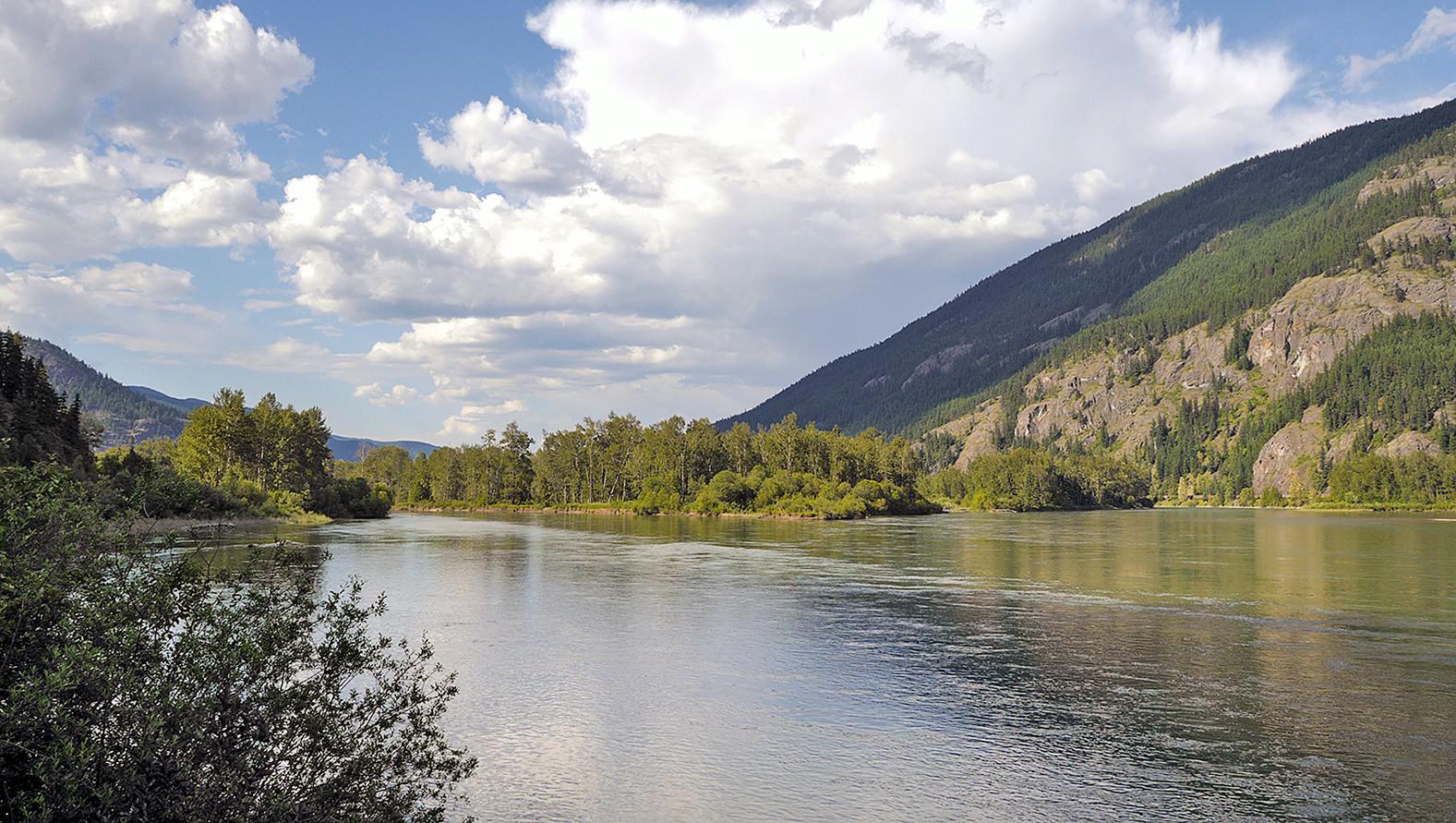
Jasper National Park and the pipeline route. The pipeline route follows along the Fraser and Thompson Rivers.
The pipeline is just a few meters away, literally, from the rivers, at many points.A pipeline rupture, could be devastating to the pristine wetlands and habitat along the pipeline route and could spell the death knell for salmon populations, which are already struggling from the impacts of climate change and open pen salmon farms. The Fraser River is arguably one of the most important, if not the most important salmon bearing river, in the world.
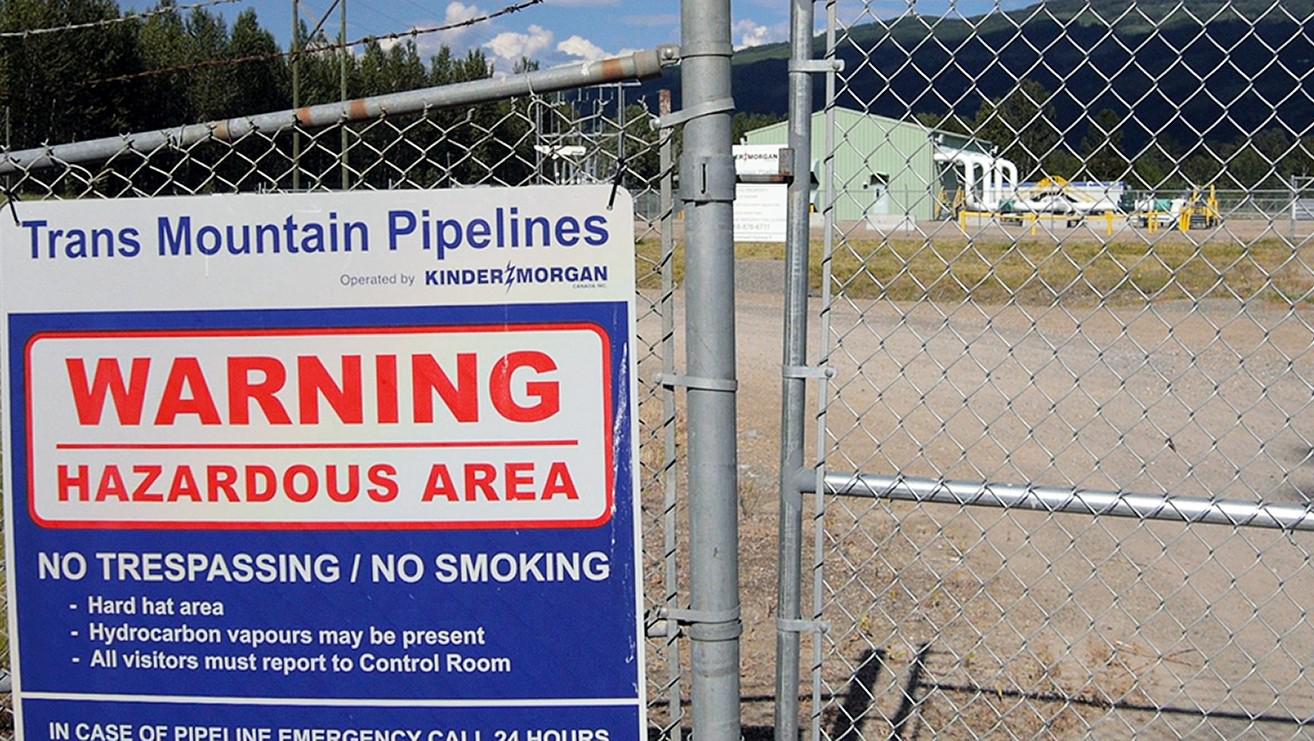
Many pumping stations are along the route. The pipeline is just a few meters away, literally, from the rivers, at many points.
3. The third bomb: The Kinder Morgan oil tanks on Burnaby Mt., are termed a “tank farm” (unconscious irony?). The expansion plan would increase storage capacity to five and one half million barrels of volatile, toxic, and highly flammable and explosive diluted bitumen. This is in a densely populated urban area in close proximity to schools, homes, and Simon Fraser University, a major university campus, atop Burnaby Mt.

An aerial view of the present Kinder Morgan oil storage tanks, at centre, on Burnaby Mt.
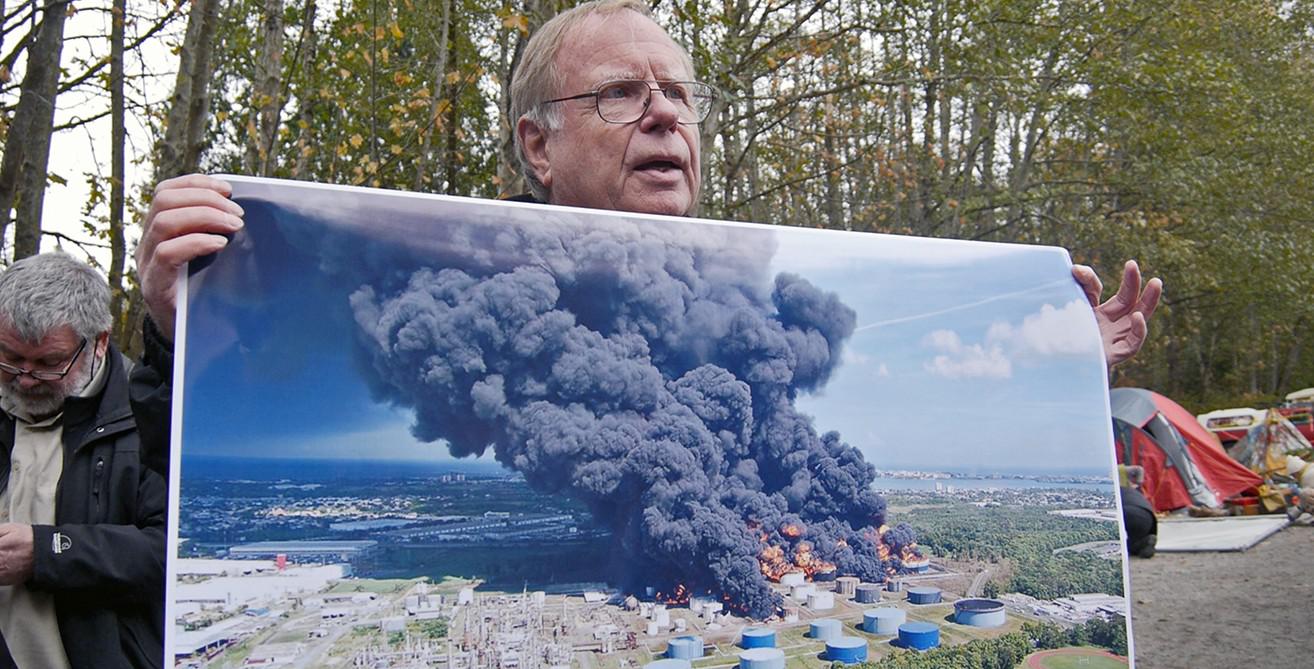
John Clarke, Burnaby resident, holds a photo of a burning oil storage tank “farm”.
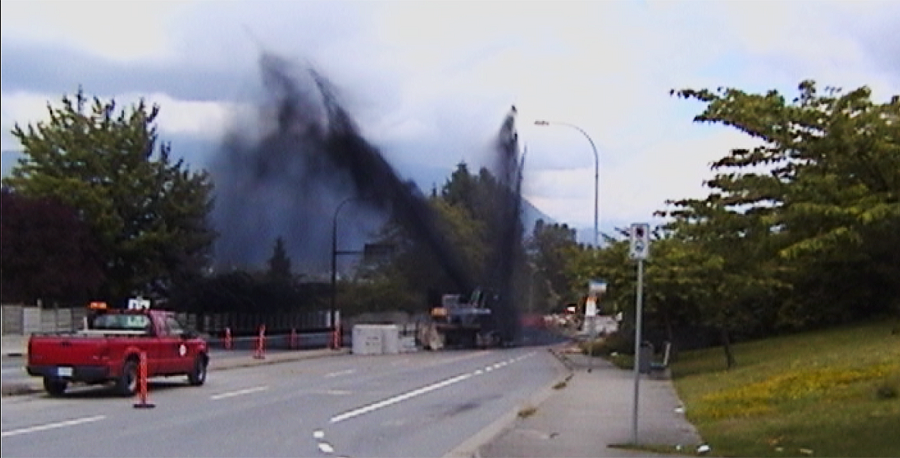
Shawn Soucy photo
In Burnaby, at 12:31 pm, July 24, 2007, a contractor ruptured the Kinder Morgan high pressure oil pipeline between Burnaby Mt. and the marine terminal. 11 homes were covered in oil, 250 residents were evacuated, 250,000 litres of oil were spilled into Burnaby Inlet, with 210,000 recovered. The clean up cost 15-17 million dollars.The Transportation Safety Board of Canada report stated, in part, under “Findings as to Causes and Contributing Factors”: 4. Inadequate communication within Kinder Morgan Canada Inc. (KMC) and between KMC, the consultant, and the contractor resulted in no common understanding or acceptance of the project work plan and the contractors construction schedule.
4. The Fourth bomb: Kinder Morgan plans a terminal expansion at Burrard inlet, to allow three huge tankers to dock at once. Presently, only one tanker can dock.
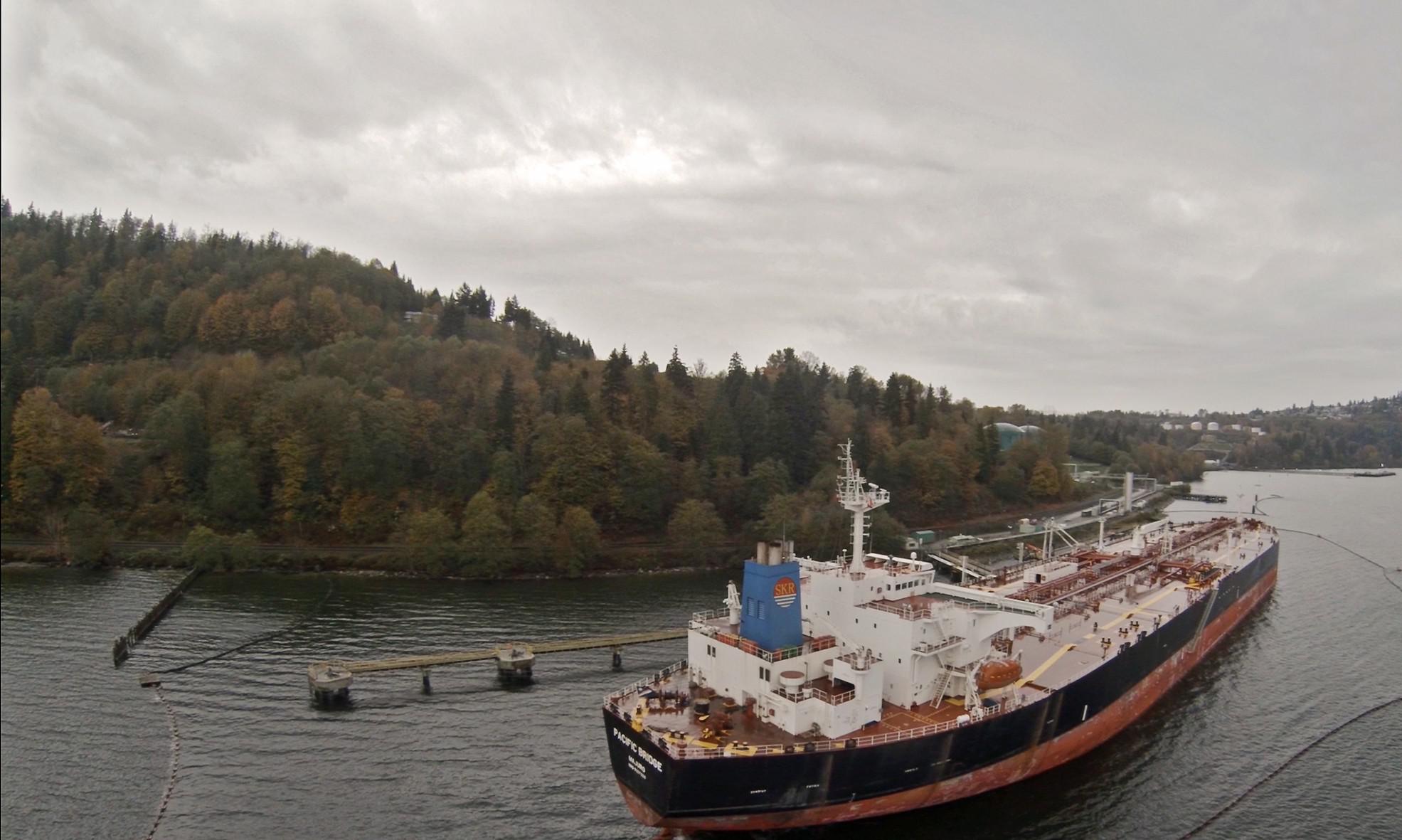
The crude oil tanker, Pacific Bridge, (formerly Ocean Lady till Jan. 2012), loading from the Kinder Morgan Westridge terminal, Burrard Inlet.
This is an Aframax class vessel, (up to 120,000 tonnes.) The specifications of this ship are DWTonnes- 105,579, port of registry, Majuro, Marshall Islands. Length- 239 metres, breadth- 44 metres, maximum draft- 20.6 metres. The Marshall Islands, like many ports of registry, are “flags of convenience”. Each ship is registered as its own corporate entity. The two liability funds are less than 1.6 billion Can$ & 1.15 billion US$. Kinder Morgan’s liability, (such as it is), ends at the end of their pipe, at the terminal. The public carries the real liability.
Currently Kinder Morgan’s single pipeline can pump 300,000 barrels per day, (bpd). The expansion plan, building a new, larger pipeline, storage tanks and larger terminal, would increase this capacity to 890,00 bpd.This would mean an increase of large Aframax class tanker traffic, through the Salish Sea, from the present approximately 4-5 each month, to 34 each month, or 408 each year. But the new planned pipeline actually has a hidden capacity. With the addition of more powerful pumps, the combined capacity of the two pipelines together, would be 1.1 million barrels per day. This would mean an increase to 475 Aframax tankers each year, or more than 9, each week.
Here is some perspective, from past records of Port Metro Vancouver. Metric tonnes of crude oil exported via Kinder Morgan’s Westridge terminal:(In 2005, Kinder Morgan bought the Trans Mountain pipeline.)
2005-1,166,538
2006-1,311,648
2007-2,138,101
2008-2,208,847
2009-3,916,333
But it wasn’t just volumes that changed and increased, due to Kinder Morgan’s aggressive expansionist policies. The Trans Mountain single pipeline was built in 1953, and for most of the time, it was carrying “conventional” petrochemical products. Lately, it has carried more and more diluted bitumen from the Tar Sands.
Each Aframax tanker leaving the terminal is loaded at 87% capacity, or less (to reduce the vessel’s draft), due to the hazardous channel restrictions at the Burrard Inlet 2nd Narrows, so each tanker can carry “only” about 575,000 barrels of oil.
At roughly 7 barrels per tonne, this equals about 82,000 metric tonnes per ship.
We cannot be absolutely accurate, since exactly what Kinder Morgan ships - the properties of the oil, such as specific gravity, the make up of diluents, such as benzene, xylene, toluene, etc. - are a proprietary “secret”, and thus, unknown to us. Local governments and even first responders do not have this information. Also, Kinder Morgan ships various oil components, and they refuse to make public exactly what they are shipping at any time.
At 408 tankers per year, this means over 33 million metric tonnes of diluted bitumen would be shipped through the Salish Sea, annually. With the addition of more powerful pumps, this could rise to 39 million metric tonnes, annually. This would mean an increase of 4,600 % over the amount shipped out in the year 2000.The possibility of an oil spill in the Haro Strait, for example, is estimated to increase by at least 375%, if all the plans for the export of thermal coal, LNG and oil, are developed.
But before the tankers can reach the Haro, or Juan de Fuca Straits, they must pass through two significant hazards; the 2nd Narrows, and the 1st Narrows, in Burrard Inlet.The 2nd Narrows channel underwater profile is very restricted. As tight as it looks from the surface, the passage is even more restricted under water. There is a pilot on board, and at least two powerful tethered tugs, one at the stern and one at the bow, with highly trained crews. No passage for these vessels is allowed after dark. This is a carefully timed precision maneuver, and even a slight deviation from the correct time or course, or a mechanical mishap or human error could result in a major incident. The tankers can only pass through, partially loaded, due to the danger of striking the bottom, and are only timed for a passage through, when loaded, at the highest high tide, at slack water.
The Port Metro Harbour Operations Manual states on page 19:3.3.2 Vessel Restrictions
5) Tankers loaded to 12.5 m or greater shall be trimmed 15 cm by the stern.
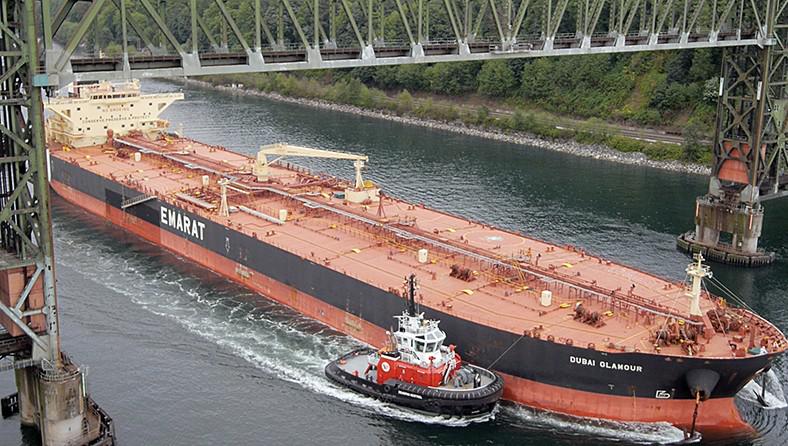 The 115,600 DWT crude oil tanker, Dubai Glamour, flag- Marshall Islands, length- 250 m., breadth- 44.6 m., passes through the 2nd Narrows, under the CN rail bridge at highest high tide, after loading at the Kinder Morgan terminal.
The 115,600 DWT crude oil tanker, Dubai Glamour, flag- Marshall Islands, length- 250 m., breadth- 44.6 m., passes through the 2nd Narrows, under the CN rail bridge at highest high tide, after loading at the Kinder Morgan terminal.
Port Metro Vancouver could dredge this channel to allow passage for fully loaded Aframax ships, or the much larger Suezmax class tankers, (up to 175,000 DWT “dead weight tonnes”) A fully loaded 275 m long Suezmax ship, can carry 1,759,200 barrels of oil. When asked about any plans for dredging here, a PMV representative said they had no plans, “at this time”.
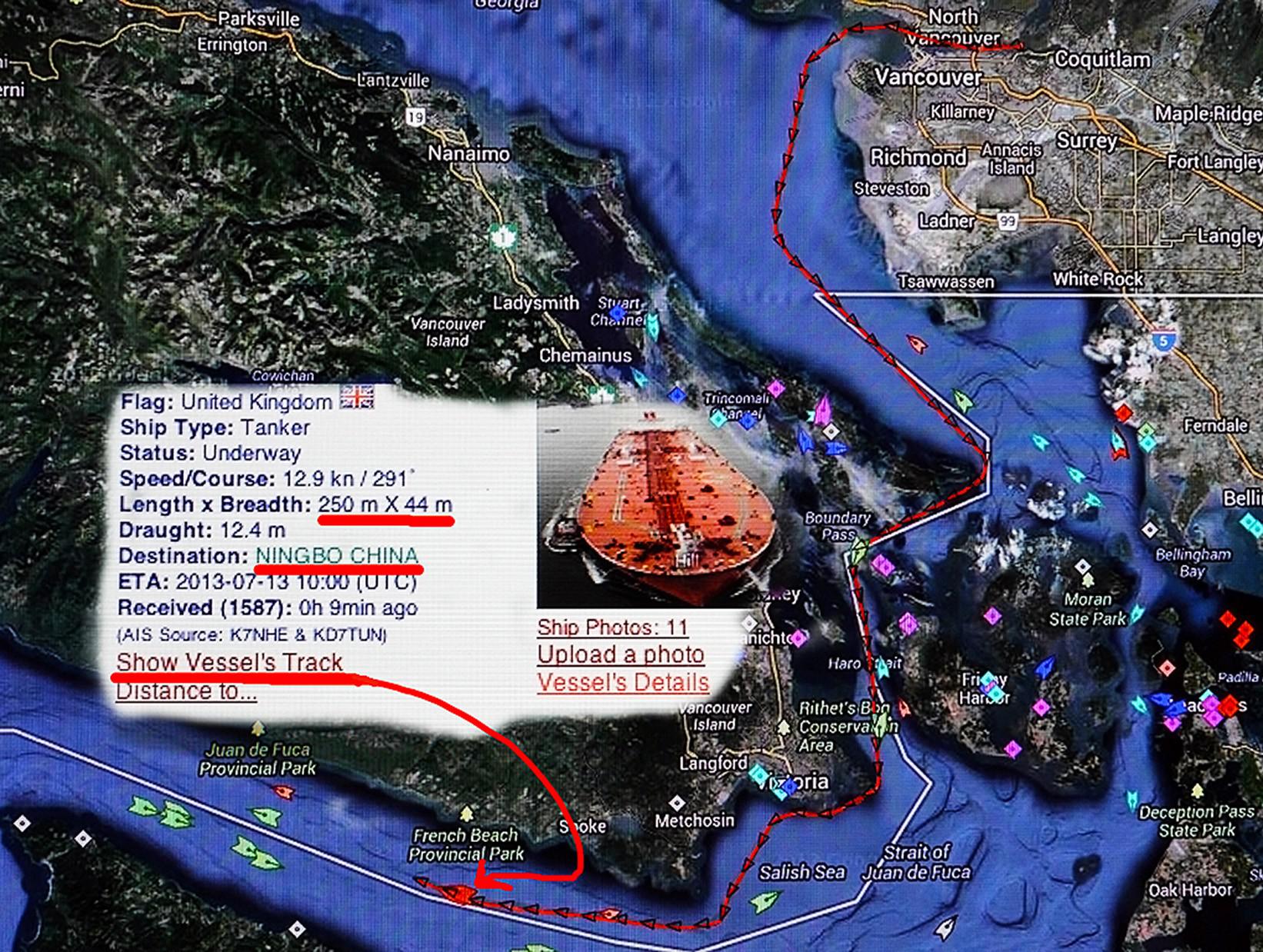
This is a screen shot from the ship tracking site, www.marinetraffic.com . This shows the vessel track for the crude oil tanker, Smart Lady, outbound, carrying oil cargo, from the Kinder Morgan terminal, to Ningbo, China. The inset shows the particulars.
On the outbound track from English Bay, this vessel came within 2 km of Pt. Atkinson, 5 km of Cowans Pt. on Bowen Island, and 18 km of Gospel Rock on the Sunshine Coast. An incident resulting in a hull rupture and a loss of just 10% of the cargo would mean a spill of 8,000 metric tonnes of diluted bitumen into the waters of the central Strait of Georgia.
In the event of a flood tide and a southeasterly wind, all of the above mentioned points could be “oiled” within a matter of hours.Later the ship came within a few hundred metres of East Pt., on Saturna Island, then within a couple of kilometres of Victoria, where the pilot was dropped off, before leaving, via the Strait of Juan de Fuca.
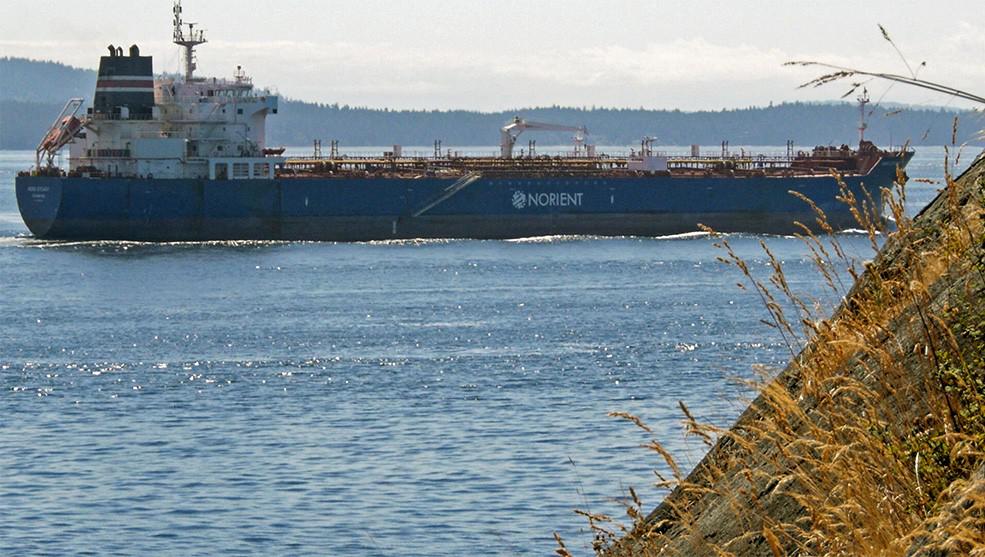
The oil tanker Nord Steady, in Boundary Pass. Specifications: Flag- Singapore, DWT- 50,000, Length- 183 m., breadth- 32 m. It is passing within a few hundred metres of East Pt., on Saturna Island, and is heading west towards the Haro Strait. The boarding ladder is in the lowered position, since they will be dropping off the pilot as they swing in within a couple of kilometres of Victoria.
Water is generally considered polluted with oil once it has about 10 mg/l of oil in, (ten litres of oil per one million litres of water.) Therefore, one litre of oil pollutes 100,000 litres of water. One metric tonne of crude oil equals about 1,106 litres. 8,000 metric tonnes equals 8,848,000 litres, which can contaminate 8.8 trillion litres of water, if dispersed evenly.
But, a spill never disperses evenly. In the case of diluted bitumen, the evaporation of diluents would occur rapidly, resulting in enormous clouds of toxic and flammable gas. Large oil slicks would form, which would drift on the surface, driven by wind and currents, injuring and killing birds, fish, mammals and planktonic life. The slicks would eventually oil whatever shoreline they came into contact with, injuring and killing all the prolific life inhabited there. The heavy oil would adhere to the rocky shorelines and the weeds, algae, and grasses. It would sink into the substrata of beaches, in poisonous layers. It would destroy prime habitat for herring, sand lance and other forage fish, which are foundational species upon which the entire marine food web depends.
However, most of the oil would sink to the ocean floor, where it would be impossible to “clean up”. Here it would lie in thousands of tonnes of mats and globs of toxic sludge, in perpetuity, covering rare and delicate glass sponge reefs, and the sediments, where countless invertebrates, molluscs, crabs and prawns, etc., make their home.
Dr. Andrew Weaver, is a noted scientist, Noble Laureate, B.C. provincial MLA and Green Party Leader. In his recent submission to the National Energy Board hearings on this expansion project, he called for an immediate halt of all tanker shipments of diluted bitumen now leaving the Kinder Morgan terminal. One of his chief concerns was with what happens when diluted bitumen is in the presence of sediment particulates, in water.
Dr. Weaver sited two recent scientific papers;
-The National Academies of Sciences: Spills of Diluted Bitumen From Pipelines: A Comparative Study of Environmental Fate, Effects, and Response
-The Royal Society of Canada Expert Panel: The Behaviour and Environmental Impacts of Crude Oil Released into Aqueous Environments.
These papers discuss how diluted bitumen has a tendency to “weather”, and to strongly adhere to sediment particles, creating tar balls that sink, (after the lighter diluents evaporate).
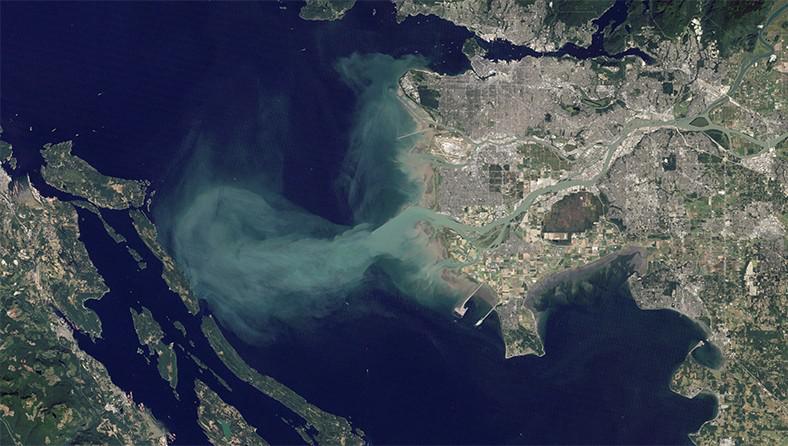
A NASA photo of the Fraser River brackish waters and sediment plume flowing out and over the surface of the heavier, saltier sea water of the Georgia Strait in the Salish Sea.
During the freshet, this plume can cover an area of up to 1,500 sq. km. The surface waters of the Salish Sea are considerably more brackish and lighter than sea water on the outer coast. This drives a process called “estuarine circulation”, where the Strait of Juan de Fuca is an “estuary”, for the Salish Sea. Here, colder, denser, saltier water finds its way into the Salish Sea, along the bottom, while warmer, lighter and more brackish water at the surface, flows seaward, creating vital mixing and exchange.
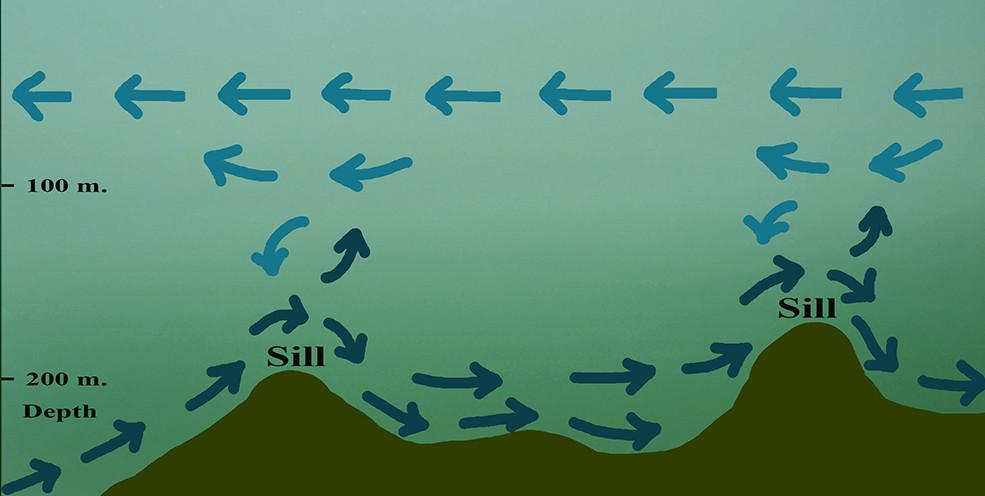
This is a simplified view of estuarine circulation, driven by wind waves, river flows, gravity, tidal currents, upwelling on the outer coast, and the coriolis effect. The light blue arrows are brackish surface waters, flowing out to sea, to the left. The dark blue arrows are cold, saltier and denser waters, flowing into Salish Sea basin, to the right.
These complex and powerful dynamics draw in vital nutrients, mix oxygen and de-stratify water layers, and have made the Salish Sea one of the most productive habitats on the entire planet.
But in a case of tragic irony, in the event of a diluted bitumen oil spill, these same processes that give life and abundance, will also ensure a devastating event to the bio-diversity of local eco-systems within the Salish Sea basin. In this sense, the dynamics at play are strikingly similar to the life blood in our bodies; while it carries vital elements and life giving oxygen, in a crisis incident, or illness, it can also deliver toxins. The key difference is that while our blood can carry away wastes, bitumen has no where to go but down, to remain as a heavy oil sludge on the sea floor. Over a great many decades, sediments will fall and eventually cover the toxic sludge. Meanwhile, we may see a severe degradation of this productive habitat and a collapse of salmon runs and herring, and a myriad of other species.
What Dr. Weaver addressed was that the Kinder Morgan spill models did not take into account the real conditions within the Salish Sea; the waters in this basin are not a static water column; they are less dense at the surface than sea water, and are laden with sediments. There are strong areas of upwelling and downwelling. All of these factors ensure that diluted bitumen will sink, in the event of a spill, whether in rivers, wetlands, streams, or indeed, within the Salish Sea. But Kinder Morgan vehemently denied this, and the National Energy Board hearings did not accept or consider the new evidence presented in the two scientific studies, mentioned above.
5. The Fifth bomb: The elevation of corporate control and the “petro-state” degrades civil society and democracy.
100 citizens who protested Kinder Morgan test drilling on Burnaby Mt. in the fall of 2014, were arrested.
In the Harper era, muzzling of science and scientists, and suppression of democratic activities were standard practice. Covert surveillance of First Nations people and concerned citizens, engaged on environmental issues, was standard practice. Auditing of environmental organizations by Revenue Canada, was instituted, to reduce charitable status and donations. But, “charities” such as the Fraser Institute, weren’t audited, despite promoting a conservative political agenda and receiving funds from the likes of oil industry billionaires, such as the Koch brothers.
The Canadian Energy Pipeline Association met with senior government officials in the fall of 2011, asking for changes in legislation. In 2012, Conservative Prime Minister, Stephen Harper, legislated Bill C-45, gutting the Navigable Waters Protection Act. This reduced protection from 2.5 million lakes and rivers, to only 159. Stephen Harper also “streamlined” the NEB, and stacked it with fossil fuel industry insiders. In the new, more “efficient” NEB hearings, one important salient fact is that Kinder Morgan can cross examine intervenors, (as when lawyers questioned the importance of salmon in the diet of First Nation intervenors), but, no one, was allowed to cross examine KM’s evidence.
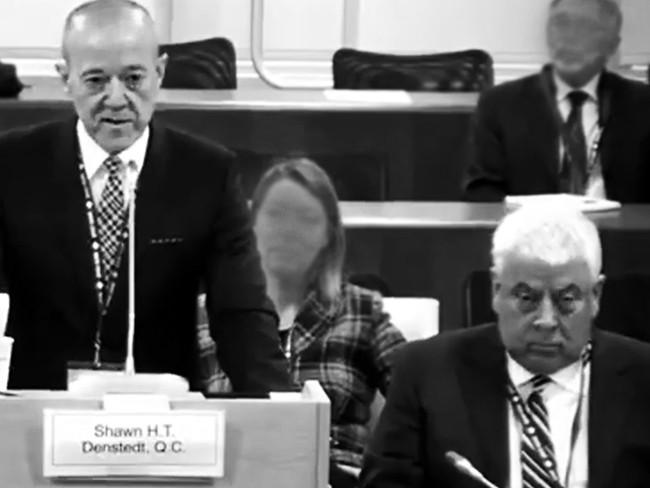 Trans Mountain President, Ian Anderson, lower right.
Trans Mountain President, Ian Anderson, lower right.
RCMP “greeting line” at the NEB,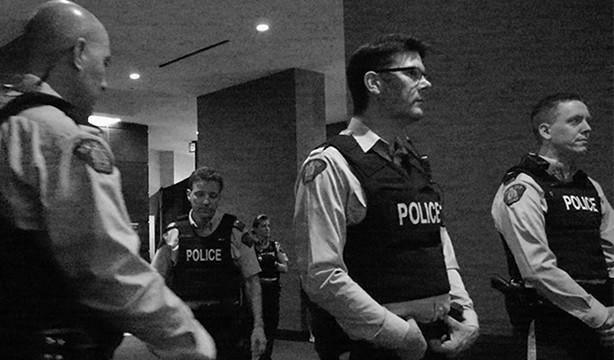 in Burnaby. and lawyer, left, presenting at the NEB, in Calgary.
in Burnaby. and lawyer, left, presenting at the NEB, in Calgary.
As intervenor and MP Elizabeth May so eloquently put it to the NEB, as part of her summation, …“the essence of cross examination, is not just an aspect of fairness to participants, it is for the adjudicators of fact, an essential way that evidence is tested and facts can be determined, and I submit to you, that there is a significant frailty to the evidence, that would not be in place, had cross examination occurred.”
Three peaceful young women who tried to attend the NEB hearing room in Burnaby,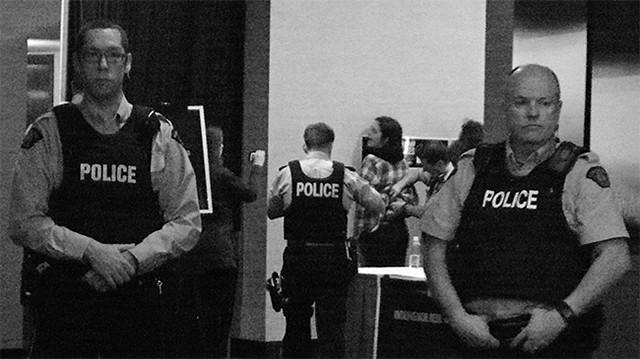 Jan. 23, 2016, with the intent of listening to the summations, were immediately arrested by the RCMP.
Jan. 23, 2016, with the intent of listening to the summations, were immediately arrested by the RCMP.
While Elizabeth May and other intervenors were presenting their summations to the NEB, in a very large, but almost entirely empty ball room, in Burnaby, the public were not allowed to attend. One hundred and ten concerned citizens have been arrested by the RCMP, while protesting the Kinder Morgan expansion plans, thus far since 2014.The NEB hearing process is tainted and is an affront to truth and justice, to First Nations, and to the best standards of civilized conduct and democracy. As such, it should be immediately halted.
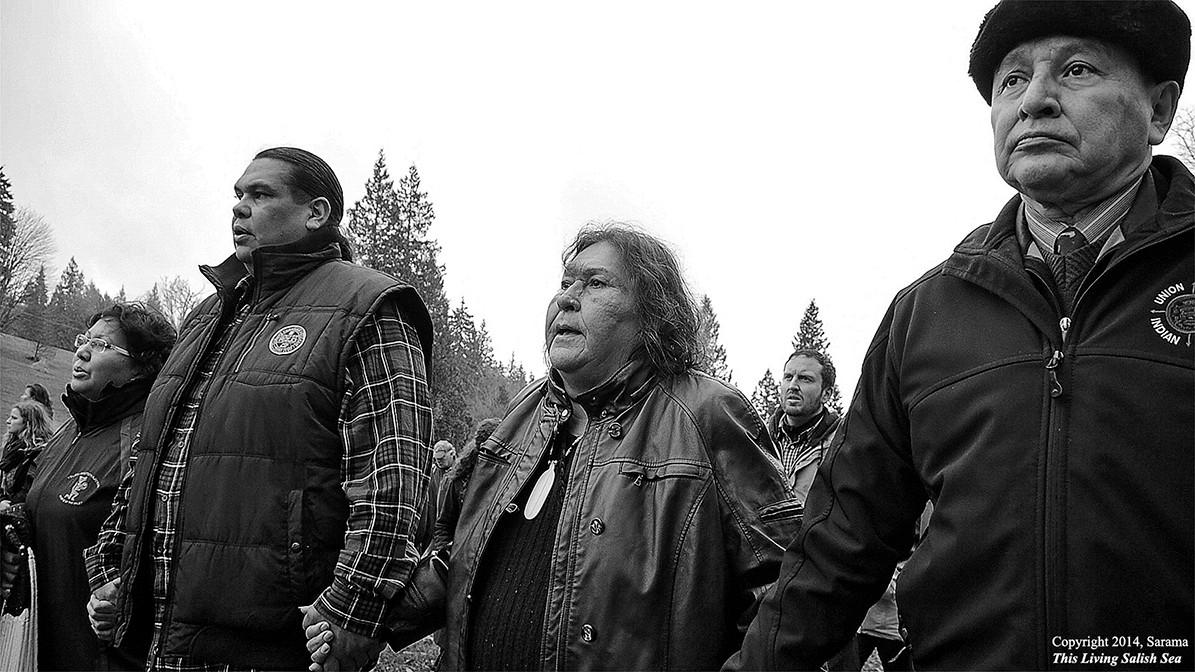
Tsleil-Waututh members, Charlene Aleck, Reuben George, Amy George, (grandson, and daughter, respectively, of Chief Dan George), and Grand Chief Stewart Phillip, stand in resistance to Kinder Morgan, on Burnaby Mt, in 2014.
The jurisdictional area here is unceded Coast Salish territory.First Nations across B.C. and Washington state signed a treaty to protect the Salish Sea. The Tsleil-Waututh First Nation, People of the Inlet, live on Burrard Inlet, their ancestral home for thousands of years, directly across from the Kinder Morgan terminal. They say they were not consulted, and do not give permission for this project. In court, and on the ground, they have been strongly opposing Kinder Morgan’s expansion plans.
6. The Sixth Bomb: Anthropogenic climate change is the deadliest bomb of all.
 Typhoon Haiyan (known as Super Typhoon Yolanda, in the Phillipines), in Nov. 2013, NASA photo. This was one of the largest storms in recorded history, with the most powerful recorded winds, upon hitting land, in recorded history, 285 km/h, (180/mph). There were billions of dollars in damage, with more than 6,000 dead. With the increasing effects of climate change, extreme weather will be the new normal.
Typhoon Haiyan (known as Super Typhoon Yolanda, in the Phillipines), in Nov. 2013, NASA photo. This was one of the largest storms in recorded history, with the most powerful recorded winds, upon hitting land, in recorded history, 285 km/h, (180/mph). There were billions of dollars in damage, with more than 6,000 dead. With the increasing effects of climate change, extreme weather will be the new normal.
Kinder Morgan’s plans will add over 100 million tonnes of Green House Gas emissions, annually, to this growing problem. CO2 absorption into the ocean becomes carbonic acid, eroding shell forming marine organisms ability to grow. This threatens much of life in the sea, our ancestral home. There are no boundaries. We are this living earth.
For future generations, stand up and speak out. To save the living treasures of this beautiful home,
say NO to Kinder Morgan.

All photos by Sarama, unless otherwise noted. Film site: www.livingsalishsea.ca
Other links: www.sanjuans.org www.twnsacredtrust.ca www.georgiastrait.org www.brokepipelinewatch.ca www.raincoast.org www.realporthearings.org www.myseatosky.org
